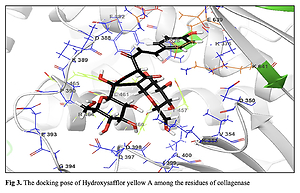Current issue
Archive
Manuscripts accepted
About the Journal
Editorial office
Editorial board
Section Editors
Abstracting and indexing
Subscription
Contact
Ethical standards and procedures
Most read articles
Instructions for authors
Article Processing Charge (APC)
Regulations of paying article processing charge (APC)
PULMONOLOGY / BASIC RESEARCH
Anti-small cell lung cancer and collagenase inhibition properties of hydroxysafflor yellow A
1
Department of Respiratory and Critical Care Medicine, Shanxi Provincial People’s Hospital, Taiyuan City, Shanxi, China
2
Department of Chemistry, Turabah University College, Taif University, Taif, Saudi Arabia
3
Department of Thoracic Surgery, Sunshine Union Hospital, Weifang City, Shandong Province, China
Submission date: 2021-05-17
Final revision date: 2021-06-08
Acceptance date: 2021-06-10
Online publication date: 2021-07-09
Corresponding author
Dianxi Yang
Department of Thoracic Surgery, Sunshine Union Hospital, Weifang City,Shandong Province, 261000, China, China
Department of Thoracic Surgery, Sunshine Union Hospital, Weifang City,Shandong Province, 261000, China, China
KEYWORDS
TOPICS
ABSTRACT
Introduction:
Hydroxysafflor yellow A is the major active chemical ingredient of Carthamus tinctorius L. (safflower), which is widely used in patients with cardiovascular and cerebrovascular diseases in China.
Material and methods:
In our study, the inhibitory effect of hydroxysafflor yellow A on collagenase showed a lower value, IC50 = 78.81 µg/ml. In the cellular and molecular part of the recent study, the cells treated with hydroxysafflor yellow A were assessed by MTT assay for 48 h as regards the cytotoxicity and anti-small cell lung cancer effects on SBC-3, DMS273, and DMS114 cell lines.
Results:
The viability of small cell lung cancer cell lines decreased dose-dependently in the presence of hydroxysafflor yellow A. The IC50 values of hydroxysafflor yellow A were 539, 432, and 416 µg/ml against SBC-3, DMS273, and DMS114 cell lines, respectively. A molecular docking study was carried out for evaluation of the biological activity of hydroxysafflor yellow A against the collagenase H from Clostridium histolyticum.
Conclusions:
The results of the docking calculations revealed the considerable binding affinity of the inhibitor to the enzyme with a docking score of –9.238 (kcal/mol). This remarkable binding affinity could be attributed to the number of hydrogen bonds and hydrophobic contacts, which are 6 and 10, respectively.
Hydroxysafflor yellow A is the major active chemical ingredient of Carthamus tinctorius L. (safflower), which is widely used in patients with cardiovascular and cerebrovascular diseases in China.
Material and methods:
In our study, the inhibitory effect of hydroxysafflor yellow A on collagenase showed a lower value, IC50 = 78.81 µg/ml. In the cellular and molecular part of the recent study, the cells treated with hydroxysafflor yellow A were assessed by MTT assay for 48 h as regards the cytotoxicity and anti-small cell lung cancer effects on SBC-3, DMS273, and DMS114 cell lines.
Results:
The viability of small cell lung cancer cell lines decreased dose-dependently in the presence of hydroxysafflor yellow A. The IC50 values of hydroxysafflor yellow A were 539, 432, and 416 µg/ml against SBC-3, DMS273, and DMS114 cell lines, respectively. A molecular docking study was carried out for evaluation of the biological activity of hydroxysafflor yellow A against the collagenase H from Clostridium histolyticum.
Conclusions:
The results of the docking calculations revealed the considerable binding affinity of the inhibitor to the enzyme with a docking score of –9.238 (kcal/mol). This remarkable binding affinity could be attributed to the number of hydrogen bonds and hydrophobic contacts, which are 6 and 10, respectively.
Share
RELATED ARTICLE
We process personal data collected when visiting the website. The function of obtaining information about users and their behavior is carried out by voluntarily entered information in forms and saving cookies in end devices. Data, including cookies, are used to provide services, improve the user experience and to analyze the traffic in accordance with the Privacy policy. Data are also collected and processed by Google Analytics tool (more).
You can change cookies settings in your browser. Restricted use of cookies in the browser configuration may affect some functionalities of the website.
You can change cookies settings in your browser. Restricted use of cookies in the browser configuration may affect some functionalities of the website.



